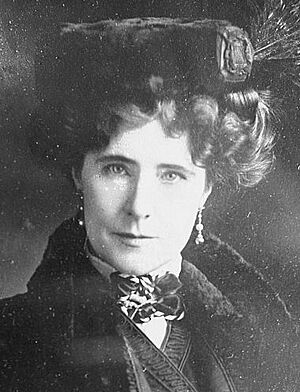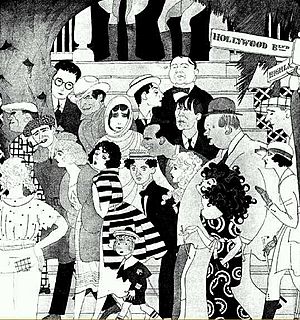Elinor Glyn facts for kids
Quick facts for kids
Elinor Glyn
|
|
|---|---|

Elinor Glyn, United States
|
|
| Born | Elinor Sutherland 17 October 1864 Jersey, Channel Islands, U.K. |
| Died | 23 September 1943 (aged 78) Chelsea, London, U.K. |
| Pen name | Elinor Glyn |
| Occupation | Novelist and scriptwriter |
| Language | English |
| Period | 1900–1940 |
| Genre | Romance fiction |
| Literary movement | Modernism |
| Notable works | Beyond the Rocks, Three Weeks, The Visits of Elizabeth |
| Spouse |
Clayton Louis Glyn
(m. 1892; died 1915) |
| Children | 2, including Juliet |
| Relatives | Lucy, Lady Duff-Gordon (sister) Sir Edward Rae Davson, 1st Baronet (son-in-law) Sir Rhys Rhys-Williams, 1st Baronet (son-in-law) Sir Brandon Rhys-Williams, 2nd Baronet (grandson) |
Elinor Glyn (born Elinor Sutherland; 17 October 1864 – 23 September 1943) was a British writer and scriptwriter. She was famous for her romantic novels, which were considered quite daring in her time. She also helped make the idea of the it-girl popular. Elinor Glyn had a big impact on popular culture in the early 1900s and helped the careers of Hollywood stars like Rudolph Valentino, Gloria Swanson, and especially Clara Bow.
Contents
Early Life and Education
Elinor Sutherland was born on 17 October 1864 in Saint Helier, Jersey, which is one of the Channel Islands in the U.K. Her father, Douglas Sutherland, was a civil engineer from Scotland. Her mother, Elinor Saunders, came from an Anglo-French family that had moved to Canada.
When Elinor was only two months old, her father passed away. Her mother then moved back to her family's home in Guelph, which was in Upper Canada (now Ontario). Elinor and her older sister, Lucy, grew up there. Elinor's grandmother, Lucy Anne Saunders, taught her about the manners and customs of upper-class society. This training helped Elinor later in life. It allowed her to mix with important people when she returned to Europe. It also made her known as an expert on style and good manners when she worked in Hollywood in the 1920s.
The family lived in Guelph for seven years. When Elinor was about eight years old, her mother remarried David Kennedy, and they moved back to Jersey. Elinor continued her education at home with private teachers called governesses. Elinor's older sister, Lucy, became a famous fashion designer known as Lucile.
Elinor Glyn's Career
Elinor married Clayton Louis Glyn on 27 April 1892, when she was 28. Her husband was a wealthy lawyer and landowner. They had two daughters, Margot and Juliet.
Elinor started writing in 1900. Her first book was Visits of Elizabeth. As her husband faced financial difficulties around 1908, Elinor wrote at least one novel each year to support her family and maintain their lifestyle. Her novel Three Weeks caused a stir in society when it was published because it was considered very bold for its time.
Around 1907, Elinor Glyn visited the United States. This trip inspired her book Elizabeth visits America (1909).
During World War I, Elinor Glyn worked as a war correspondent in France. She was one of only two women present at the signing of the Treaty of Versailles on 28 June 1919, which officially ended the war.
The "It" Girl
Elinor Glyn was a pioneer in writing romantic stories for women. In her 1914 novel The Man and the Moment, she created the famous term it. She used it to describe a special quality that "draws all others with magnetic force." She explained that with it, you can attract anyone, whether you are a man or a woman. It could be a quality of the mind or a physical charm. This idea became very popular.
Hollywood and Film Work
After World War I, Elinor Glyn went to Hollywood. She signed a contract with William Randolph Hearst's International Magazine Company to write stories and articles, which also included the rights for movies. She was hired by the Famous Players–Lasky film company to write screenplays.
She wrote for magazines like Cosmopolitan, giving advice to women on relationships and beauty. Her book The Elinor Glyn System of Writing (1922) shared tips on writing for Hollywood studios and magazines.
Elinor Glyn was one of the most famous female screenwriters in the 1920s. She has credits for writing or co-writing 28 stories or screenplays. She also produced three films and directed two. Her first script was for the movie The Great Moment, starring Gloria Swanson.
She wrote many screenplays in the 1920s, including Six Hours (1923) and the movie version of her novel Three Weeks (1924). Other films she wrote include His Hour (1924), Love's Blindness (1926), Man and Maid (1925), The Only Thing (1925), and Ritzy. Her last screenplay in the United States was for Such Men Are Dangerous in 1930.
Besides writing scripts for silent movies, Elinor Glyn also had a short career as one of the first female directors. She even made a brief appearance in the 1927 film It, which was based on her own story.
She is also known for helping to change Gloria Swanson's image from a playful star to an elegant one. Elinor Glyn also helped make Clara Bow a big star in 1927, giving her the nickname "the It girl." Clara Bow later starred in Red Hair (1928), a comedy based on Elinor Glyn's 1905 novel.
In 1929, Elinor Glyn returned to England. She started her own film company, Elinor Glyn Ltd. She directed two films for her company in 1930: Knowing Men and The Price of Things. However, these films were not successful. After her company faced financial difficulties, Elinor Glyn decided to stop working in film and focus on writing novels again.
Later Life and Death
Elinor Glyn passed away on 23 September 1943, in Chelsea, London, at the age of 78, after a short illness. She was cremated at Golders Green Crematorium.
Selected Writings
Elinor Glyn wrote many books and stories. Here are some of her most well-known works:
- Elizabeth series
- The Visits of Elizabeth (1900)
- Elizabeth Visits America (1909)
- Three Weeks series
- Three Weeks (1907)
- Single novels
- The Reflections of Ambrosine (1902)
- The Vicissitudes of Evangeline (1905), also known as Red Hair
- Beyond the Rocks (1906)
- The Man and the Moment (1914)
- "It" and Other Stories (1927)
- Non-fiction
- The Elinor Glyn System of Writing (1922)
- The Philosophy of Love (1923)
- Romantic Adventure. Being the Autobiography of Elinor Glyn (1936)
Filmography
Elinor Glyn's stories were made into many films. She also worked as a screenwriter and director.
Films Based on Her Novels
- Three Weeks, directed by Perry N. Vekroff (1914)
- Beyond the Rocks, directed by Sam Wood (1922)
- Three Weeks, directed by Alan Crosland (1924)
- His Hour, directed by King Vidor (1924)
- It, directed by Clarence G. Badger (1927)
- Red Hair, directed by Clarence G. Badger (1928)
- Knowing Men, directed by Elinor Glyn (UK, 1930)
- The Price of Things, directed by Elinor Glyn (UK, 1930)
Screenwriter
- 1921: The Great Moment
- 1925: The Only Thing
- 1930: Such Men Are Dangerous
Director
- Knowing Men (UK, 1930)
- The Price of Things (UK, 1930)
Images for kids



